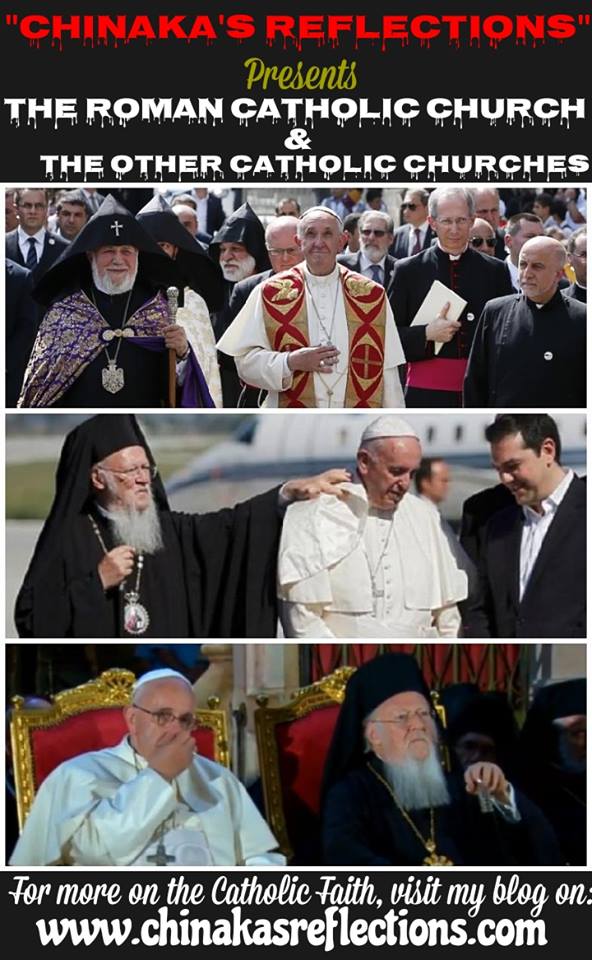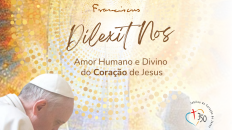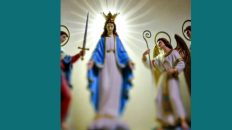Sometime around March 2018 (precisely a week to my priestly ordination), as I was about going for a retreat in preparation for my ordination, a friend sent me a write up of an anonymous author via WhatsApp trying to inquire about the veracity of its content. The article was titled: “MAJOR DEVELOPMENT IN THE CATHOLIC CHURCH IN NIGERIA”. The write up which went viral was about the creation of a new Catholic Diocese in Ibadan, Nigeria (Eparchy of Our Lady of the Annunciation) of the Eastern Rites by Pope Francis on February 28, 2018, announcing Simon Faddoul as the first Bishop. Instead of the anonymous author to explain the different rites existing in the One, Holy, Catholic, and Apostolic Church, he/she went on to centre on the priestly marriage under this rite, and this left many Latin (Roman) Catholics confused as to whether a priest can get married or not. Even the person who sent me the article was quite unhappy about the development; however, to me, the article made no difference from what I already knew and studied in Theology concerning the Rites existing in the Catholic Church. That aside, many people also were somewhat “scandalized” and some even vowed that they would leave the Catholic Church the day priests are allowed to marry. Sequel to this, I promised to come up with a clarification on the issue. Meanwhile, some authorities in the Catholic Church in Nigeria already responded to that article. According to the Archbishop Emeritus of the Catholic Archdiocese of Ibadan – His Grace, Most Rev Dr. Felix Alaba Job, “the write-up on the Maronite bishop is very shallow! It only dwelt on married/unmarried clergy. It did not tell us who are the Maronites? How is an Eparchy organized?” Likewise; His Grace, Most Rev Dr. Gabriel Agbegunrin (Archbishop of the Metropolitan see of Ibadan), and also the Catholic Bishop Conference of Nigeria (CBCN) responded respectively on the issue, clarifying the faithful on the Maronites rite.
As a follow-up, I intend to go beyond explaining the Maronite Catholics by clarifying the minds of the faithful on the different rites in the Universal (Catholic) Church in communion with Rome, together with their corresponding practices.
It may sound weird to most people, (especially Roman Catholics) to know that there exist many rites in the Universal (Catholic) Church. Before delving into this discussion, it is pertinent to briefly explain what constitutes a rite. A rite could simply be understood as a Church tradition which indicates how the sacraments are celebrated. In other words, a rite is a liturgical, theological, spiritual, and disciplinary patrimony of a distinct people manifested in a Church. Put differently, each rite uses a distinct ritual for the Mass, the Sacraments and Sacramentals. These rites came about as a result of the Church’s attempt to evangelize the major cultural centres where it was situated in the first centuries so that the liturgy could be celebrated and best understood in these places without losing it essential form and matter. The cultural centres include – Alexandria in Egypt; Antioch in Syria; and Rome. In addition, with the influence of St. John Chrysostom and St. Basil, the Byzantine rite sprang up as a major rite from the Antiochian liturgical tradition.
Today, we have 24 rites or Catholic churches:
1 Latin/Western Church (Roman Catholic where the majority of us belong), and
23 Eastern/Oriental Catholic Churches with a more historical than geographical distinction.
For a better understanding, let us consider a document of the Second Vatican Council on – DECREE ON THE CATHOLIC CHURCHES OF THE EASTERN RITE (ORIENTALIUM ECCLESIARUM), “These individual Churches, whether of the East or the West, although they differ somewhat among themselves in rite, that is, in liturgy, ecclesiastical discipline, and spiritual heritage, are nevertheless, each as much as the others, entrusted to the pastoral government of the Roman Pontiff, the divinely appointed successor of St. Peter in primacy over the universal Church. They are consequently of equal dignity, so that none of them is superior to the others as regards rite and they enjoy the same rights and are under the same obligations, also in respect of preaching the Gospel to the whole world (cf. Mark 16, 15) under the guidance of the Roman Pontiff.”
Thus, it should be duly noted that all of the Eastern Catholic Churches are fully Catholic in that they recognize the timeless Tradition (with a big “T”) of the Catholic Church, such as the seven sacraments, the primacy of the Pope, the doctrine and dogmas defined by the Magisterium of the Catholic Church, and so on. Still, the Eastern Catholic Churches are exhorted to retain their own theological understandings of doctrines and to express it in the way they have received from their bishops and teachers of blessed memory. The Maronite rite which was established recently in Ibadan, Nigeria (springing from the West-Syrian or the Antiochian liturgical tradition) is an example of the Catholic churches of the Eastern Rite. Since they belong to the Eastern rite, their Eucharistic celebration is called “The Divine Liturgy”, while we in the Latin rite call it “Holy Mass”. With regards to participation in the Holy Mass/Divine Liturgy, the laity is typically encouraged to foster an appreciation of their own rite and is invited to stick to their rite; that is, observe that rite UNLESS there is a good reason, e.g. Latin-Rite Catholics living in an exclusively Byzantine Rite community/country, then one may participate in their Divine Liturgy. However, this does not mean that one cannot occasional or even, for a just cause participate in the liturgy of a different rite, either by invitation or the likes.
Having established this fact, it must be made clear that the Latin (Roman) rite and the Eastern rites have different traditions concerning clerical celibacy. Clerical celibacy was not originally the Catholic Church’s Tradition “ab initio”. It might interest you to know that it was introduced definitively into the Latin (Roman) rite in the 12th century. Put differently, the Church was over a thousand years old before it definitively took a stand in favour of celibacy in the Latin rite at the First and Second Lateran Council held in 1123 and 1139 respectively, when a rule was approved forbidding priests to marry. In 1563, the Council of Trent reaffirmed the tradition of celibacy. Celibacy is considered an important part of the priesthood, a sign of a priest’s commitment to God and service; just as we see in 1Cor 7:32-33. Here St. Paul encourages celibacy, averring that an unmarried man is concerned about the Lord’s affairs–how he can please the Lord; while a married man is concerned about the affairs of this world–how he can please his wife. While the Roman (Latin) Rite adopted the discipline of celibacy, the Eastern Rites continued with Priestly marriage and made celibacy optional. In this regard, the bishops of the Eastern rites are selected from the priests who opted to be celibates (that is, unmarried priests). In other words, a married priest of the Eastern rite cannot be a bishop. At this juncture, I believe we now understand why the Maronite priests are permitted to marry. This is because they belong to the Eastern Rite.
Today, Roman Catholic (Latin Rite) priests are celibate. However, there are exceptions to celibacy in the Latin rite. We have Permanent Diaconate. Here, a man is ordained a deacon permanently (he does not go on to become a priest), as such, he is given the option to marry. If the deacon is to be married, his marriage must take place before his Diaconate Ordination. This is because the ordination impedes him from getting married; and once his wife dies, he cannot marry again. In addition to the exception, some Roman Catholic priests are married. These are former Anglican priests who came into the full communion of the Catholic Church and were accepted to ordination as Catholic priests. They either came in through what was called the pastoral provision (instituted under Pope St John Paul II) or through the “Ordinariate” established by Pope Emeritus Benedict XVI. These are Catholic priests. They are not some lesser category. They were granted a dispensation from the celibacy requirement.
Let us bear in mind that this discipline of celibacy for the Latin rite is not a Divine Law, and thus, it could be changed by a Pope in the future; hence, do not be scandalized about this. Presently, there is a discussion that the Catholic Church may consider an additional exception to the rule of priestly celibacy. In those regions where there are too few priests and people suffer without adequate access to the Sacraments, the Church may consider inviting married men into the priesthood, provided they are devout, proven and mature. It was around last year 2017 when Cardinal Hummes reportedly asked Pope Francis to consider ordaining so-called “viri probati”, that is, married men of GREAT FAITH, capable of ministering spiritually to the many remote communities in the Amazon where there is a shortage of priests… In an interview with Germany’s Die Zeit newspaper, the Pope said “We must consider IF “viri probati” is a possibility. Then we must determine what tasks they can perform, for example, in remote communities…” We are currently waiting for the outcome.
Having discussed these, let us take a look at the rites individually and know where they may be found.
(A) LATIN RITE/LITURGICAL TRADITION:
1. ROMAN CATHOLIC CHURCH:
Since the majority of us belong to this rite, I would not dwell much here. The Latin Catholic Church, is so large, however, that many people, even Catholics, are completely unaware of the existence of other rites. Here in the Latin rite, we are over a billion Catholics under the Supreme Pontiff (currently Pope Francis) as the visible head. If one is baptized in the Roman rite, he/she is called a Roman Catholic (not just a Catholic), because he/she was baptized under the Roman rite. Here, Latin is the official language used in the liturgies. The doctrine of the “Filoque” as contained in the Nicene Creed, has been the subject of great controversy between the Eastern and Latin Rite. The Latin term “Filioque” describes the Holy Spirit as proceeding from both the Father and the Son, (and not from the Father only). In other words, we profess in the Nicene Creed “I believe in the Holy Spirit….who proceeds from the Father and the Son…” (as contained in Scripture). For the Eastern rites, the Holy Spirit proceeds only from the Father alone (this too is given a strong theological and Scriptural support). There was so much contention over this issue that it contributed to what eventually led to the split between the Roman Catholic and Eastern Orthodox churches in A. D. 1054 – the Great Schism (East-West schism).
The Roman/Latin rite is present in the following Continents: Europe, Africa, America (North and South), Asia, Oceania, and Australia, with huge numbers of members in these regions (over one billion members).
Now, let’s briefly consider our Eastern rites catholic brethren and their practices.
THE 23 EASTERN CATHOLIC CHURCHES/RITES:
The Eastern Catholic Churches are self-governing (sui iuris) particular churches in full communion with the Pope (full communion constitutes mutual sacramental sharing between the Eastern Catholic Churches and the Latin Church, including Eucharistic intercommunion), but they retain their distinctive liturgical rites, laws and customs, traditional devotions and have their own theological emphases. Terminology may vary: For instance, the term DIOCESE is used in the Roman rite, while EPARCHY is used in the Eastern rites (though, meaning the same thing); also, vicar general (for Latin rite) and protosyncellus (for eastern rites); likewise, confirmation (used in the Latin rite) and chrismation (for the Eastern rites). In the eastern rites, the mysteries (sacraments) of baptism and chrismation are generally administered one immediately after the other according to the ancient tradition of the Church. Here, infants who are baptized and chrismated/comfirmed are also given the Eucharist (Cf. CCC 1233). The highest-ranking bishops in the Eastern rites are called Patriarchs. They do not believe in the doctrine of the Filioque. They have a stronger devotion to the Blessed Virgin Mary; despite this, they believe that Mary was Immaculate only from the moment the Angel Gabriel appeared to her and the power of the Holy Spirit overshadowed her, and not from the moment of her conception. In other words, they reject the doctrine of the Immaculate Conception of Mary which the Latin rite believes.
Together with the Roman (Latin) Church, they make up the Catholic Church. The rites here are as follows:
B. ALEXANDRIAN LITURGICAL TRADITION
2. COPTIC CATHOLIC CHURCH – Situated majorly in Egypt
3. ERITREAN CATHOLIC CHURCH – majorly in Eritrea
4. ETHIOPIAN CATHOLIC CHURCH – majorly in Ethiopia
C. ANTIOCHIAN (WEST SYRIAN OR ANTIOCHENE) LITURGICAL TRADITION
5. MARONITE CATHOLIC CHURCH – situated majorly in Lebanon, Cyprus, Jordan, Israel, Palestine, Egypt, Syria, Argentina, Brazil, United States, Australia, Canada, Mexico, and now in Nigeria – Ibadan.
6. SYRIAC CATHOLIC CHURCH – in Lebanon, Iraq, Jordan, Kuwait, Palestine, Egypt, Sudan, Syria, Turkey, United States and Canada, Venezuela
7. SYRO-MALANKARA CATHOLIC CHURCH – India, United States.
D. ARMENIAN LITURGICAL TRADITION
8. ARMENIAN CATHOLIC CHURCH – in Lebanon, Iran, Iraq, Egypt, Syria, Turkey, Jordan, Palestine, Ukraine, France, Greece, Latin America, Argentina, Romania, United States, Canada, Eastern Europe.
E. CHALDEAN (OR EAST SYRIAN) LITURGICAL TRADITION
9. CHALDEAN CATHOLIC CHURCH – in Iraq, Iran, Lebanon, Egypt, Syria, Turkey, United States
10. SYRO-MALABAR CATHOLIC CHURCH – in India, United States.
F. BYZANTINE (CONSTANTINOPOLITAN) LITURGICAL TRADITION
11. ALBANIAN CATHOLIC CHURCH – in Albania
12. BELARUSIAN CATHOLIC CHURCH – in Belarus
13. BULGARIAN GREEK CATHOLIC CHURCH – in Bulgaria
14. BYZANTINE CHURCH OF CROATIA, SERBIA AND MONTENEGRO (OR KRIŽEVCI CATHOLIC CHURCH) – in Croatia, Serbia and Montenegro
15. GREEK BYZANTINE CATHOLIC CHURCH – in Greece, Turkey
16. HUNGARIAN GREEK CATHOLIC CHURCH – Hungary
17. ITALO-ALBANIAN CATHOLIC CHURCH – in Italy
18. MACEDONIAN CATHOLIC CHURCH – Republic of Macedonia
19. MELKITE GREEK CATHOLIC CHURCH – Syria, Lebanon, Jordan, Israel, Jerusalem, Brazil, United States, Canada, Mexico, Iraq, Egypt and Sudan, Kuwait, Australia, Venezuela, Argentina
20. ROMANIAN CATHOLIC CHURCH – in Romania, United States
21. RUSSIAN CATHOLIC CHURCH – in Russia, China; currently about 20 parishes and communities scattered around the world, including five in Russia itself
22. RUTHENIAN CATHOLIC CHURCH (ALSO KNOWN AS THE BYZANTINE CATHOLIC CHURCH IN THE UNITED STATES) – in United States, Ukraine, Czech Republic
23. SLOVAK CATHOLIC CHURCH – in Slovak Republic, Canada
24. UKRAINIAN GREEK CATHOLIC CHURCH – in Ukraine, Poland, United States, Canada, Great Britain, Australia, Germany and Scandinavia, France, Brazil, Argentina.
From what we have seen thus far, it would be appropriate to indicate our rites when next we identify ourselves as Catholics. For example, I’m a Roman Catholic or I’m a Byzantine Catholic, and so on…
Since after the great schism, it could be said that the Eastern and Latin rites are back to full communion. Under the Code of Canons of the Eastern Churches (Canon 1 & 43), the Pope has supreme, full, immediate and universal ordinary authority in the whole Catholic Church, which he can always freely exercise, including the Eastern Catholic churches, and their leaders.
Finally, the Latin and the Eastern rites (according to Pope Saint John Paul II) are the left and right lungs of the Catholic Church; thus, the Church must breathe well with her lungs. In all these, the Church remains One, Holy, Catholic and Apostolic Church. The differences in rites should not be understood as division.
Shalom!





This is wonderful. I just learned many things now. Kudos dear Fr. I will chat you up privately for my questions for fast reply.